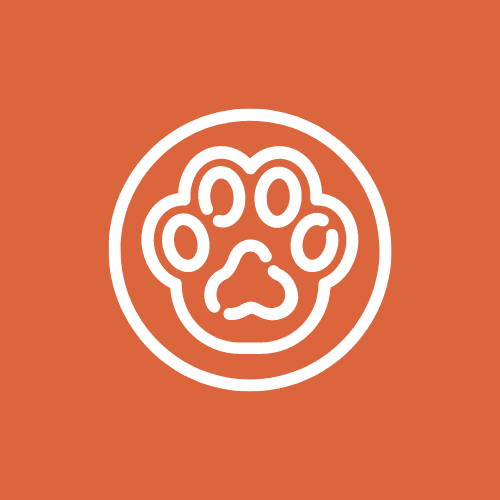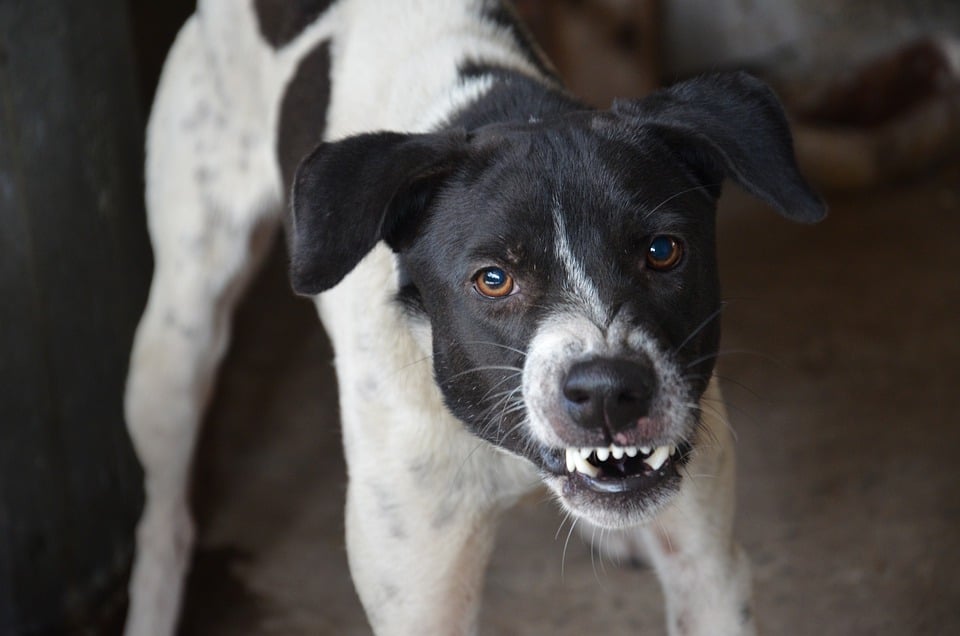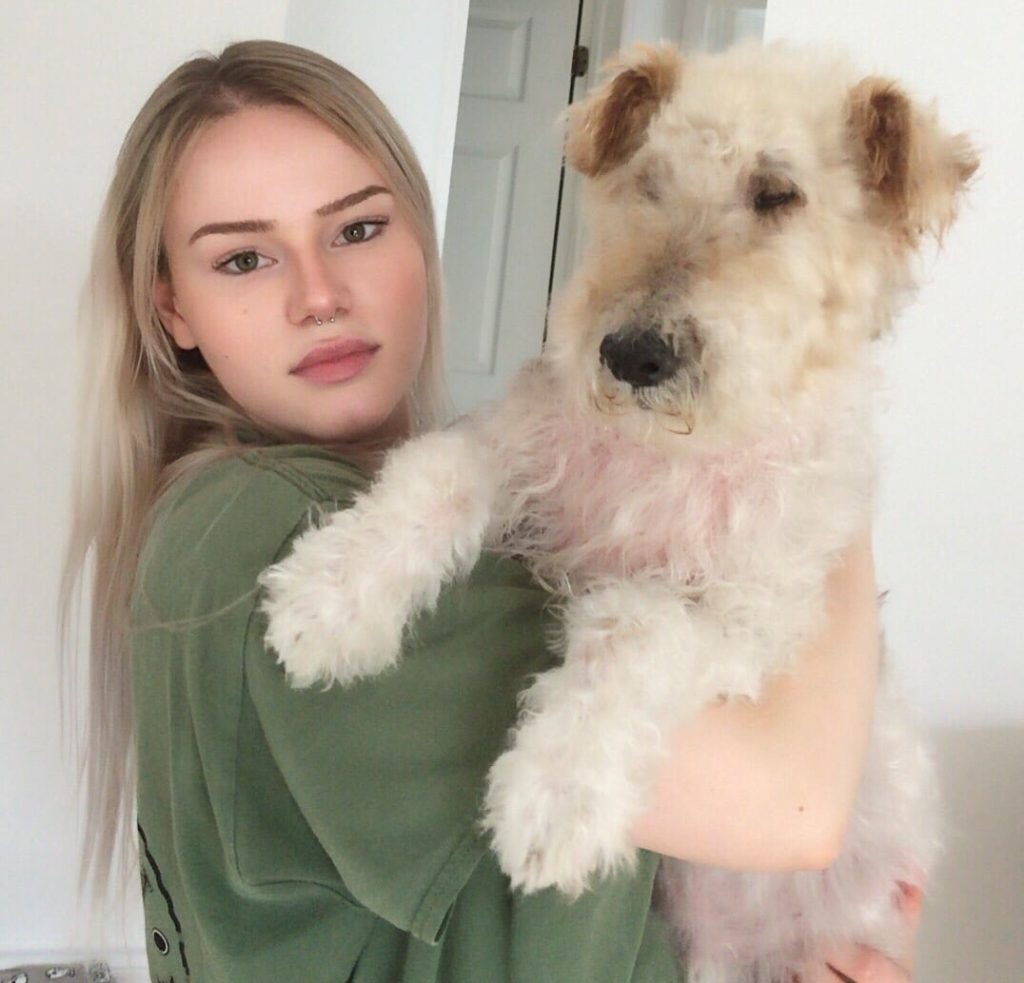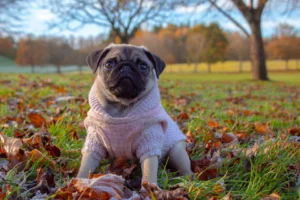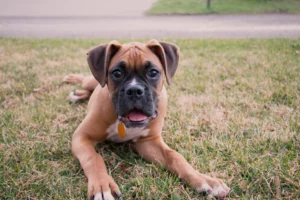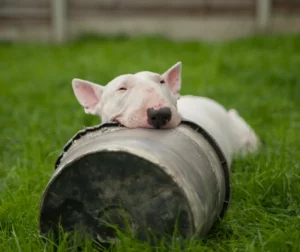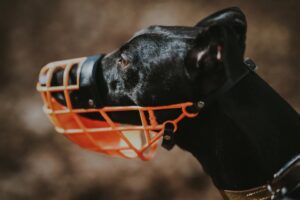Resource guarding is a complex behavior. It is also one of the most common types of aggression in dogs. You have probably already noticed a dog growling if someone passes too close to his bowl during his meal. In this situation, the dog shows aggressive behavior, but resource guarding can also be expressed in more subtle ways.
Not all dogs will express resource-guarding behavior in the same way. It is mainly that the dog wants to keep something in his possession. For example, it can be a person, an object, food, or even a specific place like the couch or the bed.
A dog that shows signs of aggression is a risk to everyone around it, especially young children. However, it is possible to solve the problem yourself with your dog.
What is Resource Guarding?
Resource guarding is also called “possessive aggression” when a dog shows signs of aggression when he wants to control access to a resource he owns. It can also be seen in humans. For example, when two children fight over a toy or want to be the first to sit in the front of the car. We also do it when we lock the doors of our homes or when we write our names to identify something we don’t want anyone to take.
Resource guarding is a genetic and natural behavior. It is a way for the predator to fight for its survival. It is used to control primary access to a valuable item, edible, place, or person.
Although your pet probably has everything he needs, he may still be afraid of having them taken away. This is why one might think that he reacts “for nothing”, but in fact, it is because his perception may be wrong. Thus, he could identify you as a threatening person, even if this is not your intention.
The dog that shows signs of aggression when he thinks he owns someone or something can snap, growl, show his teeth, and bite. Also, depending on the dog’s genetics, he may show more resource-guarding signs than others.
Why Is My Dog Resource Guarding?
A dog that demonstrates avoidance, rapid ingestion, or aggressive behavior tries to communicate its insecurity to us. It is extremely important to respect his signals so as not to affect the bond between the owner and his dog and to solve the problem.
In general, resource guarding is caused by the animal’s anticipation of having a resource he considers valuable removed. Depending on what he is protecting, the resource is a source of stress in his family or it has already been in the past. This is why the dog perceives its owner or someone else, as a threat.
Depending on his predisposition, a very scared dog will have a fight, flight, or freeze response. For example, a dog that tends to attack when he is afraid is predisposed to show more signs of aggression when he anticipates having a resource taken away.
All behaviors fulfill a specific function. A dog that growls or demonstrates aggressive behavior does not do it for pleasure, it seeks to create distance to avoid conflict. This is why humans must respect their signals and give them distance.
What Influences Resource Guarding Behaviours in Dogs?
A dog that develops resource-guarding behavior is influenced by several different factors. This includes the owner’s attitude, his approach, and how he interacts with his dog when he has a resource.
A dog’s experiences and genetics will influence it to do resource guarding. For example, privileges, training methods, and access to resources will all influence a dog’s perception of developing this behavior.
The privileges may be owners allowing the dog to eat from their plate, allowing him on furniture, and the frequency of physical and mental activity. It is not a question of prohibiting certain privileges, but of knowing how to react well to the reactions of their dog.
Dogs that are more impulsive and those that are more fearful are more likely to show signs of possessive aggression. Neutered males and mixed breeds are also more likely to show signs of possessive aggression.
The dog that has a bone, an object or his food bowl removed while eating will be more likely to express more severe or more frequent resource-guarding behaviors.
Also, the dog may have experienced a situation where he ran out of water or food in the past. It is common to see this behavior in stray dogs since access to resources can be complex.
A bored dog is a contributing factor to multiple problems, including resource guarding, aggression, depression, and anxiety. This is why it is essential to meet the physical and mental needs of your pet.
Should We Dominate Our Dog Who Protects Resources?
It is not uncommon for humans to perceive a dog’s growl as an insult or affront. It is simply a way for the dog to express discomfort and fear.
Thinking that you have to dominate or intimidate your dog to stop the behavior is problematic and is often one of the factors why the problem persists or worsens over time.
No, do not try to dominate or intimidate a dog. Trying to show him who is the “alpha” interferes with learning. The theory of dominance between humans and dogs does not exist. Moreover, it has been debunked for several years by the same person who made the theory.
We can’t dominate dogs since we are not of the same species. The term “dominant” and “submissive” only applies between dogs and are circumstantial. These are terms that have been misused over the years.
Being dominant is not a character trait. Rather, it is a term used to describe the relationship between animals. It is a relationship that does not require the use of force. This reduces the potential for conflict to ensure the safety and survival of the group.
Thinking that you have to dominate or intimidate your dog to educate him, you prevent him from learning self-control and do not show him what to do. This results in an unbalanced, unconfident, and unhappy dog. By educating him in this way, we create an unpredictable and impulsive dog who can present behavioral problems, including possessive aggression.
Is It Possible to Prevent Resource Guarding?
Resource guarding reveals patterns of behavior that can be detected before aggression arises. By knowing how to recognize the first signs of resource guarding, you can prevent the problem from turning into aggression.
Yes, it is possible to prevent resource guarding even before seeing signs of aggression. By knowing how to recognize the signs of avoidance and rapid ingestion, as well as providing environmental enrichment, it becomes easier to prevent the problem from happening or getting worse.
An avoidant dog can manifest itself in many ways. For example, he might position his body or head to maintain control over an object or he might change location with the object. Above all, he wants to block access to a resource he owns.
As for rapid ingestion, he may try to ingest a consumable as quickly as possible. This can be dangerous for your dog, as he could obstruct his airway. For example, he might try to ingest his bowl or bone too quickly.
What Are the Behaviours to Look Out for When Approaching a Dog?
It is possible to recognize the precursors of aggression in a dog. These are signals of discomfort that he communicates to you with his body language.
Each time his signals are not respected, he thinks that he must find another way that could be more intimidating to scare away the threat. A stressed dog will have tense muscles that can be seen especially in his face.
These are the signals that are important to recognize:
- Lip licking
- Ears flat on the head
- Stop eating and freeze
- Change location with object
- Avoid gaze
- Fixes an invisible point and freezes
- Piloerection (hair on dog’s back goes up)
- Positions his body or head above the resource
- Ingest a consumable quickly
- Put his paws or snout on the resource
- Growl: to create distance
- Bark or be intimidating
- Snaps or pretends to bite you
- Biting: This is the last stage, bites can get worse
How to Create an Enriching Environment for Dogs?
By providing a multitude of positive experiences to your dog, you can reduce his fear. This way, you can prevent or help resource guarding and many other behavioral problems.
To create an enriching environment, it is important to meet the basic needs of your dog every day. More specifically, every dog needs:
- Spend himself physically
- Be mentally stimulated
- Masticate
- Get attention
- Socialize
Be sure to provide enough physical and mental exercise depending on your dog’s breed and give him a dog bone or chewing toy every day.
Just like humans, dogs need to socialize. This is why it is important to socialize your dog well when he is a puppy. Puppies should be socialized with strangers, passing dogs, food handling, and more.
Plus, by using positive reinforcement to train your dog, he’ll trust you no matter the situation. This way, you will have a dog that is predictable, confident, and enjoys social interaction.
To stimulate your dog’s brain, you can use an interactive bowl, or a licking mat or teach him a new trick. You can also use a Kong, which will allow him to satisfy his chewing urges while stimulating his brain.
If you need advice on choosing a suitable chew toy for your dog, you can check out our article “Dog Bones and Chews: The Best and the Worst“.
How to Stop Resource Guarding?
The methods for stopping resource guarding are different depending on what your dog wants to protect. On the other hand, offering him an enriching environment and creating a bond and trust is the first step to solving the problem in the long term.
It is important to know that the owner greatly influences the attitude of the dog in the presence of a resource.
Using positive reinforcement is the best way to build trust. In this way, you will have a dog who wants to listen to you, because he knows that the consequence will always be positive.
Confrontation methods, such as yelling, punishing, or using force, will have the opposite effect and only work in the short term. Thus, your dog may decide to listen to you only because he is afraid of the consequences, which increases his stress level and the risk of aggression.
**When training, use high-value treats like cheese, sausage, or beef liver. The more appetizing your treats are for your dog, the quicker he will understand the exercise.**
My Dog Protects the Couch or My Bed
Having a bed is essential for your dog. He needs to have his own space where he feels safe and will not get disturbed. So, if his bed is yours or he doesn’t have a bed, it would be best to get him one that will be his.
Method #1
It is possible to make your dog understand that he does not have to show signs of resource guarding to be on your bed or the couch and that he must share.
To do this, each time he shows signs of aggression when he is on the couch or bed, take a tempting treat and encourage your dog to go down by placing the treat on the ground.
Only when all 4 paws are on the ground you can give him the treat.
Once he has eaten his treat on the floor, allow him to come back up. Repeat the exercise every time your dog shows signs of resource guarding in that same location.
It’s important to let your dog think, so he can make his own decisions. By letting him decide for himself, you allow him to learn and exercise his brain. Do not force your dog to go down, you risk making the situation worse by increasing his stress level.
If you are having difficulty getting your dog down or are afraid of being bitten, it would be best to contact a dog trainer who is familiar with resource guarding. He will be able to set up a protocol that will be adapted to your situation.
Method #2
You can also completely prohibit access to the couch or your bed. If you want to prevent your dog from climbing these places, you should NEVER allow him to do so. This rule must apply at all times including everyone in contact with your dog. If you allow him once in a while, it creates inconsistency in his learning. This will make it harder for your dog to understand that he has no right to be there.
Take him down every time he tries to climb and reward him by petting him, giving him treats, or his favorite toy.
By rewarding him, you show him that it is more pleasant for him to be on the ground than on the couch or your bed. Over time, he will understand that going there is useless since he is always denied access.
My Dog Protects His Food, His Bone, or His Bed
The first thing to do is not to disturb him when he is eating or when he is in bed. If you try to remove his bowl or approach him, it will make the problem worse and you risk being bitten.
Your dog is afraid of having his food or place taken away, so he communicates his discomfort to you with his body language. When he understands that his signals are useless, he tells himself that he must bite so that you understand that he needs space. The goal is to be able to recognize the above-listed precursors of aggression before seeing signs of aggression.
Resource guarding can be linked to several problems, including the bond with his owner. This is why a dog that is protective of his bowl or bed is a behavior that can be difficult for owners to work on.
A dog trainer who is familiar with resource guarding can help you find the source of the problem and put a protocol in place.
As mentioned above, it is important to provide an enriching environment for your dog. Offering him an interactive bowl is a good way to prevent him from ingesting his food bowl too quickly.
Additionally, some owners notice an improvement in using an interactive bowl. Also, it is important to work on the bond between you and your dog. Building trust takes time but it will be beneficial for both of you.
4 Exercises to Build Trust With Your Dog
#1 – Drop a high-value treat when he’s eating
Approach your dog calmly when he is eating or when he is in bed and drop a high-value treat beside his bowl.
A high-value treat could be cheese, chicken, sausage, or any other food your dog loves. The better the treat is in his eyes, the more successful the exercise will be.
Don’t lean over and act like you’ve dropped the treat without realizing it. In other words, don’t look, touch or talk to him. Move slowly, stay calm, and don’t stand too straight since it can be intimidating for your dog.
Repeat this exercise every time he eats his meal or a bone. This way, your dog will understand that your approach is not threatening, but positive.
#2 – Hand feed your dog
This method will allow him to understand that you are there to share and not to steal his food. Do not pet him while he’s eating, stay calm and relaxed, and always move slowly. This will build trust between you and your dog.
#3 – Whenever your dog is calm, give him treats
Your dog will mirror your emotions, so when you come up to him, stay calm and relaxed. Anxious and fearful dogs may hide from you. Using positive reinforcement is powerful to build trust and it will impact his mental health.
#4 – Let your dog come to you
Take a high-value treat and let him take the treat. If your dog roughly takes the treat or drops it, this means that he is anxious and fearful. It also means that your dog needs his space and does not want to be touched.
You can demonstrate your love by talking to your dog slowly, making slow gestures, blinking slowly at him, and sitting on the floor with him. Offer your dog more treats and repeat the exercise as many times as possible without trying to pet him.
If your dog slowly takes the treat and eats it, you can then slowly pet him under the chin or on his chest. It is best not to raise your hand since it can be intimidating.
My Dog Is Protecting Me From Strangers
A dog that is guarding his owner is a sign that he thinks he owns it. In most cases, it is an unhealthy relationship and indicates that the dog has a lack of stimulation and self-confidence. He then associates his owner with a source of security essential for his survival.
This behavior is more often seen in small-breed dogs, such as the Chihuahua. However, this behavior can also be seen in any dog breed.
For small dogs, owners will overprotect them by holding them. This prevents him from having experiences and gaining confidence.
This problem can be difficult to solve depending on the severity of the problem. In some dogs, the fact of no longer taking him in your arms, using positive reinforcement, and enriching his environment can help.
For others, it is more complex to know the cat cause that creates this toxic relationship. So, it can be difficult for owners to know what they need to work on with their dogs.
Reaching out to a professional dog trainer will help you work on your relationship by knowing exactly how to change your dog’s emotions to restore emotional balance.
How to Manage a Dog Who Is Overprotective of His Owner
#1 – Keep control of your personal space and don’t let your dog guide your actions
For example, it often happens that a couple gets separated by the dog when they get closer. As you may know, dogs can feel jealousy. He might get between the two of you, bark, jump up, or any other behavior that shows he wants your attention.
It is important not to respond to this kind of behavior and ignore it completely. As soon as he is calm, reward him with pets. This way, your dog will understand that he needs to work and behave to get your attention.
#2 – When you have guests over, keep your dog on a leash or bring him to another room
Make sure your guests are safe by keeping your dog away or by keeping him close to you. This way, you will have more control over your dog. When he is calm, reward him with praise and treats.
You can also muzzle train your dog if you think he would bite one of your guests or a stranger when you walk your dog. Make sure that your dog has a positive association with his muzzle before using it.
#3 – Obedience training is a must
Teaching him to stay will greatly help your dog to control his impulses. Your dog needs to have rules and structure to be able to have self-control.
Also, teaching your dog loose leash walking or heel will help him control himself from pulling you toward the stranger.
When your dog becomes good at responding to cues, you can ask him to sit-stay, down-stay, or go to bed, instead of ignoring him. This way you show your dog what he can do instead of wanting your attention. Here too, don’t forget to reward him with pets when he is calm.
Expose your dog to new experiences, places, and people so he can get confident and understand that not everyone wants to hurt you.
My Dog Steals and Guards Items
Your dog could guard a facial tissue, shoes, or any other item he wants to own. If your dog hasn’t learned to share, he may have a hard time letting anyone near his possessions. A dog can guard or steal an object for several reasons:
A) A dog that steals items, like your phone or your shoe, and runs away wants to tell you that he wants your attention
If you run after your dog, you are giving him what he wants. This reinforces the behavior and he will be more likely to try to reproduce the same situation to get your attention. Also, this indicates that he lacks physical and mental activity.
B) A dog runs away with an item and tries to swallow it as quickly as possible
This can be dangerous for your dog’s health. He could choke or experience gastrointestinal obstruction. For the most part, this situation happens with a bone, but he could also ingest an object dangerous to his health.
C) When your dog has an object, your approach indicates that there will be a conflict
This situation brings great stress to your dog. He doesn’t understand why you’re mad at him and it scares him. He doesn’t know he took something he shouldn’t and he thinks you want to steal his treasure.
3 Exercises to Teach Your Dog How to Share
#1 – Control the environment and meet basic needs
Be sure to keep objects out of his reach and provide him with an enriching environment, as mentioned above. Your dog needs to build his confidence and trust you. Make sure he can spend his energy, masticate, be mentally stimulated, and have new experiences every day.
#2 – Teach your dog to trade
If he has an object or a bone in his mouth, offer him something in exchange that is as attractive or even more so. For example, if your dog has one of your shoes, trade it with one of his favorite toys or a high-value treat. As soon as he drops it, tell him “Drop it” and then give him the toy or the treat.
This way you give him something he likes in exchange for your item and everyone comes out as a winner. This will make him understand that you don’t want to steal the object from him and that your approach does not announce a conflict.
Also, he learns that the words “give it” mean that he must drop the object to receive a reward. Thus, he anticipates a positive consequence instead of being afraid of the consequence.
#3 – Teach the “give it” cue when playing with him
To do this, take a low-value item and exchange it for a high-value treat. For example, take a ball and throw it. To get the ball back, offer him a high-value treat in exchange for the ball. As soon as he drops it, tell him “Drop it”, then give him the treat. Then throw the ball back and repeat the exercise.
Thus, your dog understands that he will always come out as the winner when he gives you an object. Letting your dog make his own decisions teaches him self-control.
Will My Dog Ever Stop Resource Guarding?
Resource guarding is normal behavior to survive in the wild. If your dog would share his valuable resource, he wouldn’t be able to survive.
By providing him with positive experiences, meeting his basic needs, building a strong bond, and having the right training methods, you can help your dog.
Resource guarding is controlled by fear and impulsiveness. This is why teaching your dog self-control is beneficial for him to be confident, predictable, and happy.
If you have implemented all the methods and you are unable to change your dog’s emotion, it would be best to contact a dog trainer or behaviorist who is familiar with resource guarding.
Bibliographic Sources:
